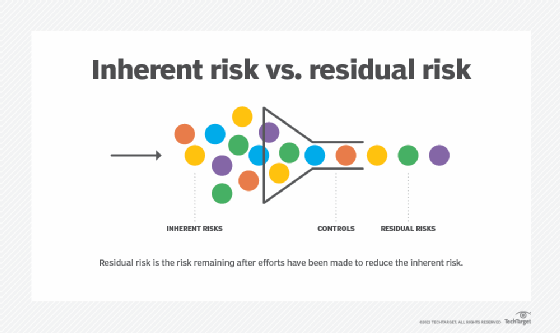Inherent risks are the security risks within an IT ecosystem in the absence of security controls. Residual risks are the security risks that remain in an IT ecosystem after security controls have been implemented. Some security controls introduce additional residual risks, known as secondary risks
Inherent Risk is typically defined as the level of risk in place in order to achieve an entity’s objectives and before actions are taken to alter the risk’s impact or likelihood. Residual Risk is the remaining level of risk following the development and implementation of the entity’s response.
I can provide you with information about inherent and residual risks in the context of CISSP (Certified Information Systems Security Professional).
Inherent Risk: Inherent risk refers to the level of risk that exists in a system or process without any controls or mitigations in place. It represents the potential risk exposure before any security controls have been applied. In the context of CISSP, understanding inherent risk is essential for identifying the baseline risk level and prioritizing security measures.
Residual Risk: Residual risk, on the other hand, is the remaining risk that remains after applying security controls and mitigations to reduce the inherent risk. It indicates the level of risk that still exists despite implementing various security measures.
In CISSP, it’s crucial to assess both inherent and residual risks to develop an effective risk management strategy. Identifying the inherent risk helps to determine the initial risk posture of an organization, while evaluating the residual risk helps assess the effectiveness of the implemented security controls and identify areas that may still require improvement.
CISSP candidates should have a good understanding of these concepts, as risk management is a fundamental domain in the CISSP certification exam.
Please note that the information provided here is a general overview. For a more comprehensive understanding and to prepare for the CISSP exam, it’s advisable to refer to official study materials, textbooks, or online resources specifically tailored for CISSP exam preparation.
General
Inherent Risk: Inherent risk refers to the level of risk that exists in a process, activity, or system without any controls or mitigation measures in place. It represents the risk before any action is taken to reduce or manage it. In other words, it is the risk inherent in the nature of the activity itself. Inherent risk is influenced by various factors such as the complexity of the process, external factors, uncertainty, and the potential for errors or failures.
Residual Risk: Residual risk, on the other hand, is the level of risk that remains after implementing control measures or mitigation strategies to reduce the inherent risk. It represents the risk that is still present despite efforts to minimize it. Residual risk takes into account the effectiveness of risk management actions and reflects the risk that an organization or individual is willing to accept as part of their operations.
The relationship between inherent and residual risk can be represented as follows:
Residual Risk = Inherent Risk - (Effectiveness of Control Measures)
The goal of risk management is to reduce inherent risk to an acceptable level and bring the residual risk within the organization’s risk tolerance.
Both inherent and residual risks are essential concepts in risk assessment and management, helping organizations make informed decisions to protect their interests and assets.
If you need further assistance or have more specific questions about inherent and residual risks, feel free to ask!
